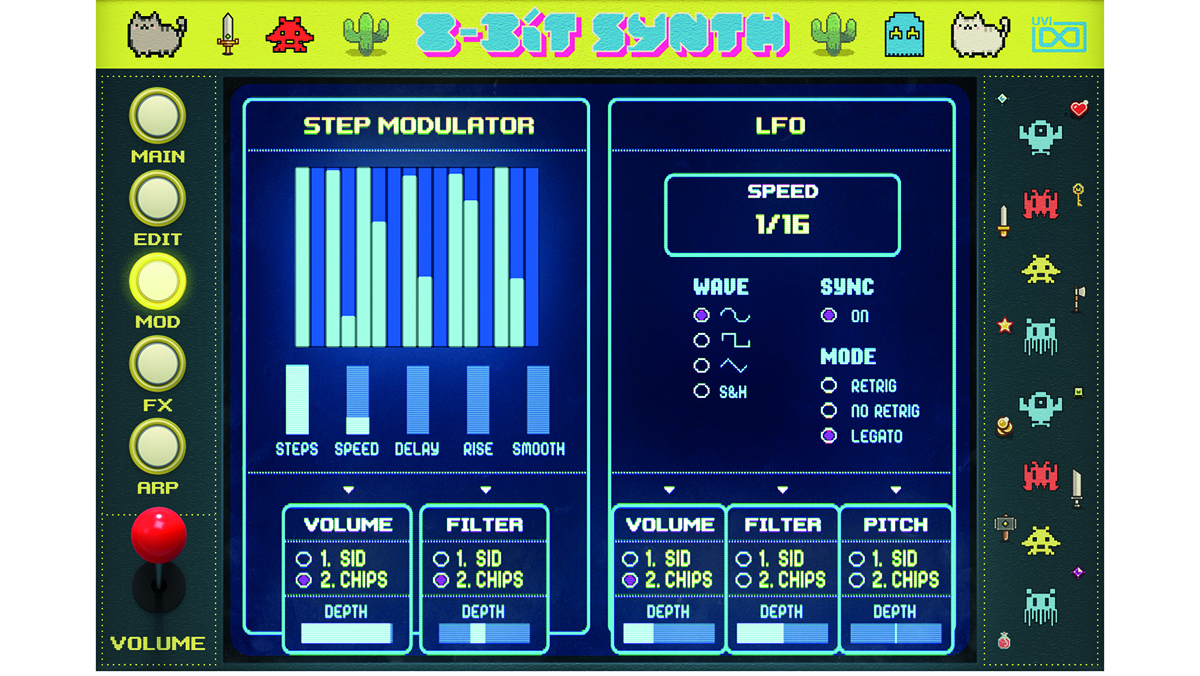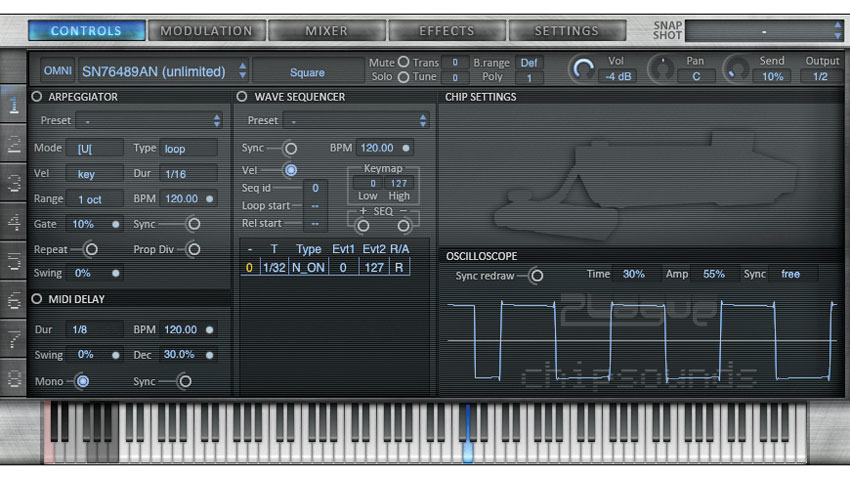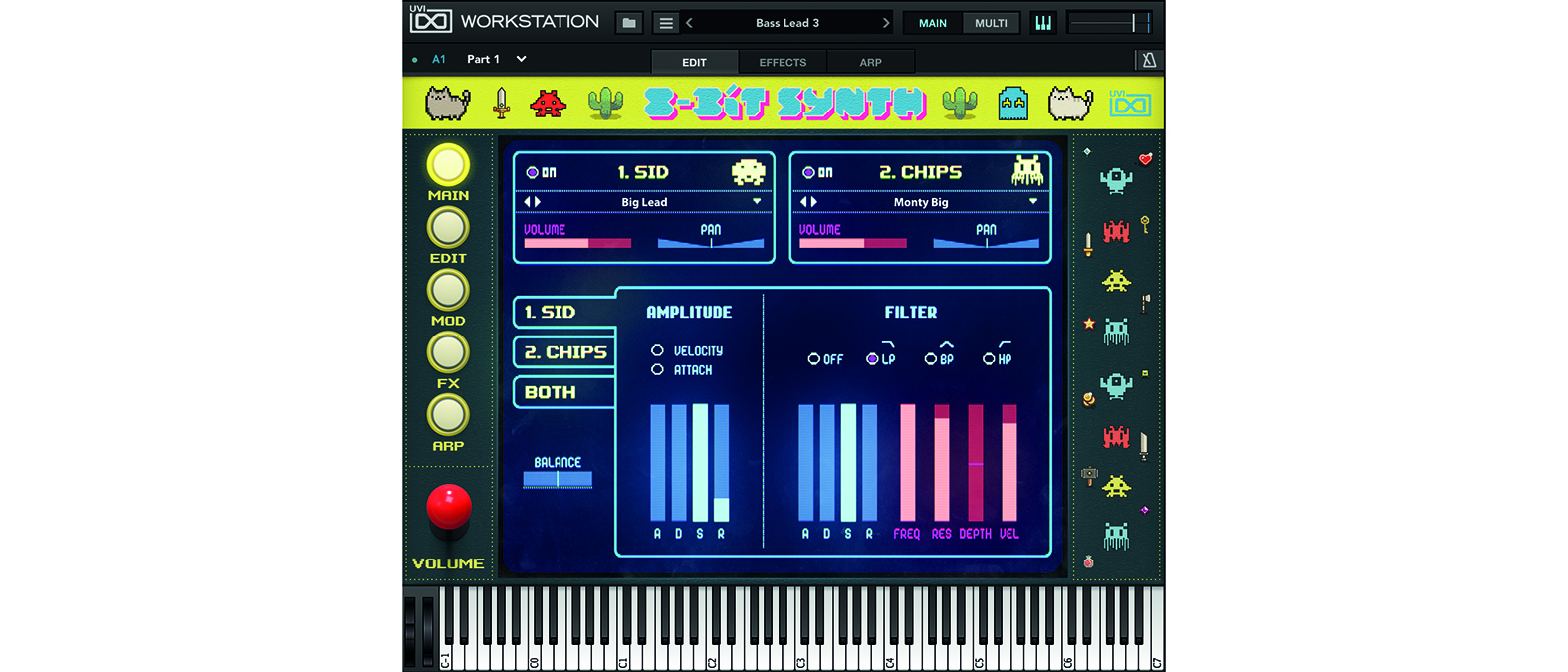MusicRadar Verdict
Hard to remember a more enjoyable time with a plugin. 8-Bit Synth doesn’t just provide aural nostalgia, but heaps of sound modifying potential. UVI wins.
Pros
- +
Meticulously sampled retro sounds.
- +
Diverse effects, arps and modulation options to sculpt sounds to taste.
- +
Dual-layer engine blending.
- +
Awesomely fun and instantly accessible.
Cons
- -
Limited long-term appeal.
MusicRadar's got your back
What is it?
Over the last ten years, we’ve seen a boom in media aimed at scratching that 80s nostalgia itch, from Stranger Things’ infatuation with the era’s cinematic tropes (and a lush synth soundtrack), Wonder Woman’s recent colourful adventures in 1984 and the trend for the bleeps and bloops of classic, 8-bit video game soundtracks that pepper EDM and even creep their way into mainstream soundtracking. It seems that as long as there are sentimental memories to conjure, the past will never die.
With that in mind, Paris-based UVI has painstakingly built what, at first glance, appears to be the ultimate retro sample library and performance instrument, specifically tailored for 8-bit music-makers. First bundled as part of their gleefully fun, humungous Toy Suite (2019), the 8-Bit Synth now stands on its own two feet…
Taking its inspiration largely from vintage video games, arcade machines and early computer-sounds, 8-Bit Synth provides 30,000 individual samples, and 375 retro-tinged patches, all of which are neatly organised into a diverse array of categories, including Bass, Leads, Chords, Composite, Drums, FX, Plucks and Polysynth, all selectable via the familiar UVI Workstation framework which houses this (and, indeed all) UVI software.
These presets have been carefully sampled, and are ready to serve as the building blocks of a quirky chip-tune track, or as flavourful sprinkles to layer over more conventional fare.
The building blocks of a quirky chip-tune track… or flavourful sprinkles over more conventional fare
Though it may seem a niche product, a cursory skim through some of these presets showcases the variety of sonics on offer, ranging from the purposefully nostalgic such as Crispy Dream, which provides a rewarding ‘twinkle’ effect, reminiscent of picking up a coin in Super Mario to the more sound design-oriented DMG Artefacts, which presents a shifting sea of processed sound.
Of course, these presets are highly tweakable, mainly via the Amplitude and Filter controls, which are presented as the central options on the Main window.
The sound engine running the show here is actually divided into two. The first layer harnesses the cherished tone of the three-voice SID chip, originally used within the beloved Commodore 64. The second consists of a variety of Chip sounds cribbed from machines like the GameBoy and Mod Machine. These layers can be blended in a whole range of ways, leading to some interesting aural creations.
Want all the hottest music and gear news, reviews, deals, features and more, direct to your inbox? Sign up here.

Would you like chips with that?
Formerly the domain of dedicated enthusiasts, chiptune music is typically made via the use of trackers. Making 8-bit music was originally a delicate procedure, though there are now many software trackers to choose from, many of which float around the web as freeware and, if you’re curious about delving further, you should certainly take for a spin.
The most noticeable difference to a traditional DAW being that the track lanes are vertically aligned. Shared characteristics among multiple trackers are the ability to modify samples, notes, effects, patterns and orders. Notable artists in the 8-bit genre include 8bitpeoples label founder Nullsleep and renowned soundtracker Jake Kaufman (aka Virt).
8-Bit Synth presents a way into this world previously restricted by the need to adjust your process to the upside-down approach, demanded by the tracker. UVI has done the hard work for you, and provides ready-to-go samples from both computers and gaming systems.
The plugin’s familiar parameters and controls, and of course, the ability to work with it within a DAW environment, allow your lo-fi concoctions to live happily alongside all manner of instrumental bedfellows.
Performance and verdict
The UI is comfortingly child-like, daubed with decals that are based on some of those iconic video game characters. The arcade machine-feel is complemented further by the circular page selection buttons that run down the left-hand side, culminating in a rendering of a classic joystick, which controls the master volume.
The five main control pages are Main, Edit, Modulation, Effects and Arpeggiator, and it’s on the Main view that we can easily select which layer to activate, edit (via the Amplitude and Filter controls) and modify global settings such as Pan and Volume.

The Edit page is where the nuts and bolts of 8-Bit synth can be manipulated. Here, you can toggle between mono and poly voicing per chip (or both) adjust portamento depth and time, scale the pitch in octaves and route our controller keyboard modwheel to familiar parameters such as vibrato, filter and tremolo.
The Modulation page justifies the inclusion of ‘Synth’ in the product’s name, as it’s here you can go to town on step modulation, LFO speed, waveshape, sync and mode, as well as deeper, layer-specific, modifications.
The Effects page contains EQ settings, as well as Drive, Chorus (or, UVI’s patented ‘Thorus’, rather), Delay and Reverb amongst others, all of which have powerful bearing on the resulting shape and feel of the tone.

• Plogue Chipsounds
Realistically emulating vintage 8-bit sound chips, this is a more serious synth, but harder to learn
• AudioThing miniBit
Similarly meant for quick-fire chiptune sonics, its waveforms came from classic consoles
The final page is perhaps where some of the most fun experiments can be undertaken. The Arpeggiator invites us to build up rolling arpeggios, with myriad options for speed, steps and note velocity. This is where you can really start to bring some of the retro tones to life, layering up evolving, bright riffs that scream to be foregrounded in your mixes.
All these options are remarkably easy to understand, and with its visual ethos being in-keeping with old school arcade machines, it feels less like work, more like a game. The editing of parameters like the amp envelope and LFO routing are made extraordinarily simple, and arguably child-friendly.
In fact, aside from 8-Bit Synths’ own attributes, it’s also potentially a great ‘way-in’ piece of software that could be used to quickly – and enjoyably – demonstrate the principles of synthesis to newcomers.
Game over
By taking a fastidious approach to sampling, UVI has yielded a treasure trove of classic video game-recalling textures and tones. The application of these can vary massively, but during a few hours of initial experimentation, you can build up your own little video game themes, that wouldn’t sound out of place in a seaside arcade back in 1989.
If you’re an indie game developer, with a penchant for the retro, then this could prove a valuable tool. For the rest of us, a satisfying diversion into the quirky realm of 8-bit provides fun – and nostalgia – by the bucket load, coupled with the potential to build out some truly original sounds by probing its nuances
MusicRadar verdict: Hard to remember a more enjoyable time with a plugin. 8-Bit Synth doesn’t just provide aural nostalgia, but heaps of sound modifying potential. UVI wins.
The web says
"With 8-Bit Synth, UVI has released an excellent tool for creating classic arcade sound without the need for trackers and their fiddly, archaic programming. The sounds here are superb, the effects are simple yet powerful, and the ability to layer two completely different chip engines grants you brilliant and unusual results that you can easily use in modern music. Highly recommended!"
MusicTech
"For adding a bit of a different sound source to your composition, this instrument proves to be brilliant. Need some out-of-the-ordinary sounds for lead or bassline? Maybe some effect for middle 8? By choosing a sound from 8-Bit Synth, you can easily add something fresh, slightly silly, original and unique."
Sound Bytes
Hands-on demos
UVI
Ave Mcree
Specifications
- SIZE: 12.8 GB (FLAC lossless encoding, was 35.01 GB in WAV)
- CONTENT: 31,402 Samples, 375 Presets, 430 Layers (187 SidMachines and 243 SidStation)
- SAMPLE RESOLUTION: 44.1kHz. Recording at 88.2 kHz
- SYSTEM REQUIREMENTS: Runs in UVI Workstation version 3.0.16+, and Falcon version 2.1.1+, iLok account (free, dongle not required),
Mac OS X 10.9 Mavericks to macOS 10.15 Catalina (64-bit), Windows 8 to Windows 10 (64-bit), 13GB of disk space, Hard Drive: 7,200 rpm recommended or Solid State Drive (SSD), 4GB RAM (8 GB+ highly recommended for large UVI Soundbanks) - CONTACT: UVI
Computer Music magazine is the world’s best selling publication dedicated solely to making great music with your Mac or PC computer. Each issue it brings its lucky readers the best in cutting-edge tutorials, need-to-know, expert software reviews and even all the tools you actually need to make great music today, courtesy of our legendary CM Plugin Suite.

